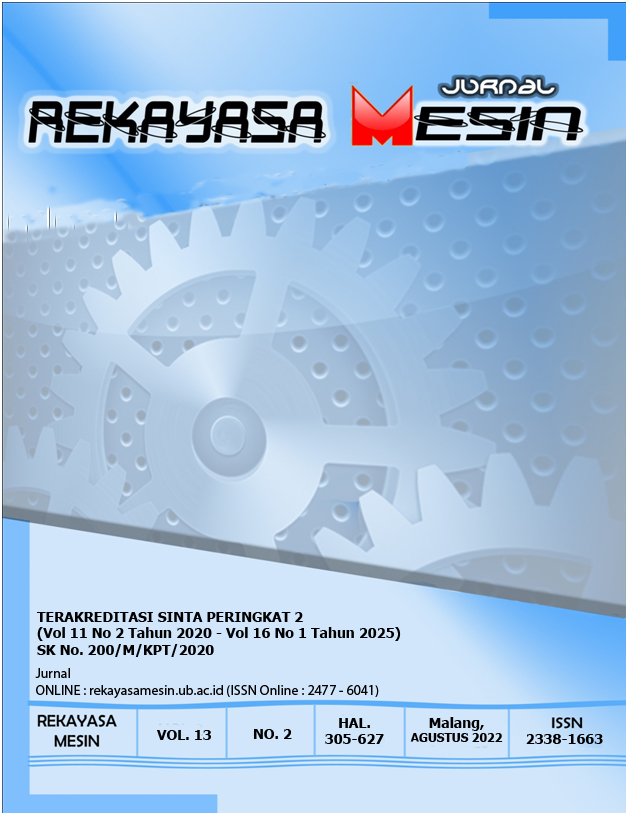EFFECTS OF CROSSWIND ON THE DRAG OF MEDIUM SPEED TRAINS
DOI:
https://doi.org/10.21776/jrm.v13i2.1011Keywords:
Wind Tunnel, ANSYS, Medium Speed Train, Finite Volume Method, CrosswindAbstract
Aerodynamic research on medium-speed trains is trying to map the flow of fluid around trains. The train model testing is conducted to study Cd values experimentally using a closed-loop wind tunnel at the Balai Besar Teknologi Aerodinamika, Aeroelastika, dan Aeroakustika. In addition to the experimental method, the computational method can be used to validate the experimental results, map the fluid flow around the train model, and calculate Cd values. The computational results of Cd obtained using ANSYS are compared against Cd values from wind tunnel tests. Further analysis using the ANSYS program with variations in the yaw angle can predict crosswind effects on the train model. It is found that vortices are formed around the train body, and modifying the head shape and adding fairing increases Cd values.
References
T. J. MUELLER AND J. D. DELAURIER, "Aerodynamics of High Speed Trains," Annu. Rev. Fluid Mech., vol. 35, no. 1, pp. 89–111, 2003.
FEDERAL AVIATION ADMINISTRATION, “Aerodynamics of Flight,” Pilot. Handb. Aeronaut. Knowl., pp. 2–5, 2000.
P. D. L. DARMOFAL, “Lift and Drag Primer,” Dep. Aeronaut. Astronaut. Massachusetts Institute Technol., p. 400, 2004.
S. M. SALLEH, M. S. M. ALI, S. A. Z. S. SHAIKH, I. A. ISHAK, M. SHIRAKASHI, AND S. MUHAMMAD, "Aerodynamics characteristics around simplified high-speed train model under the effect of crosswinds," ARPN J. Eng. Appl. Sci., vol. 12, no. 8, pp. 2604–2609, 2017.
A. M. BIADGO, A. SIMONOVIC, J. SVORCAN, AND S. STUPAR, “Aerodynamic characteristics of high speed train under turbulent cross Winds: A numerical investigation using unsteady-RANS method,” FME Trans., vol. 42, no. 1, pp. 10–18, 2014.
G. A. CLAYTON, “Bogie Design.,” vol. 1, 1984.
G. MANCINI, A. MALFATTI, A. VIOLI, AND G. MATSCHKE, “Effects of experimental bogie fairings on the aerodynamic drag of the {ETR} 500 high speed train,” Proc. World Congr. Railw. Res. WCRR 2001, Col., pp. 1–16, 2001.
Y. WANG AND Z. SUN, “Influence of the topological structures of the nose of high-speed maglev train on aerodynamic performances,” Am. Soc. Mech. Eng. Fluids Eng. Div. FEDSM, vol. 2, 2021.
H. CHOWDHURY, F. ALAM, S. ARENA, AND I. MUSTARY, “An experimental study of airflow behaviour around a standard 2-man bobsleigh,” Procedia Eng., vol. 60, pp. 479–484, 2013.
C. J. BAKER AND N. J. BROCKIE, “Wind tunnel tests to obtain train aerodynamic drag coefficients: Reynolds number and ground simulation effects,” J. Wind Eng. Ind. Aerodyn., vol. 38, no. 1, pp. 23–28, 1991.
J. BARTL, “Wind tunnel experiments on wind turbine wakes in yaw: Effects of inflow turbulence and shear,” Wind Energy Sci., vol. 3, no. 1, pp. 329–343, 2018.
J. KEOGH, T. BARBER, S. DIASINOS, AND D. GRAHAM, “The aerodynamic effects on a cornering Ahmed body,” J. Wind Eng. Ind. Aerodyn., vol. 154, pp. 34–46, 2016.
M. ATHANASSIADOU, “Wave and form drag: Their relation in the linear gravity wave regime,” Tellus, Ser. A Dyn. Meteorol. Oceanogr., vol. 55, no. 2, pp. 173–180, 2003.
L. SALATI, P. SCHITO, AND F. CHELI, “Wind tunnel experiment on a heavy truck equipped with front-rear trailer device,” J. Wind Eng. Ind. Aerodyn., vol. 171, no. November 2016, pp. 101–109, 2017.
S. PUTU GEDE GUNAWAN TISTA, I. GUSTI AGUNG KADE SURIADI, AND P. PAGEH ASTAWA, “Pengaruh Penempatan Penghalang Berbentuk Segitiga di Depan Silinder dengan Variasi Kecepatan Aliran Udara terhadap Koefisien Drag,” J. Rekayasa Mesin, vol. 6, no. 3, pp. 157–161, 2015.
Downloads
Published
Issue
Section
License
Copyright (c) 2022 David Prayoga Paramaputera, Sheila Tobing, Matza Gusto Andika

This work is licensed under a Creative Commons Attribution-NonCommercial 4.0 International License.

This work is licensed under a Creative Commons Attribution-NonCommercial 4.0 International License.











